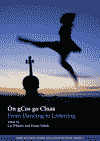
LIZ DOHERTY & FINTAN VALLELY (Eds) - Ón gCos Go Cluas: From Dancing To Listening
Aberdeen University Press ISBN: 9781857520736
NAFCo - the North Atlantic Fiddle Convention - was established in 2001 by the Elphinstone Institute at the University of Aberdeen, and combines a folk festival with an academic conference. There have been six such events to date, each held at a different location, and resulting in a publication summarising the work presented.
This most recent book catalogues the 2012 event held in Derry City. Thirty-two papers are published, loosely grouped around the theme of the separation of traditional music from its roots in the accompaniment of dance. This in itself is a fascinating field of study, and is generally viewed in a positive light: “for a half century…traditional dance… is no longer the chosen social meeting ground for today’s young people; the music instead has gone back into itself as an independent aesthetic form and re-emerges with astonishing virtuosity…”
The collection is broad and diverse, with topics geographically covering Cape Breton (3), Quebec, Newfoundland, Norway (4), Ireland (7), Scotland (7), Galicia, Mississippi, Appalachia, England, Siberia and others.
Some of the papers stick closely to the overall theme of the conference; most interesting to me was the offering by Daithí Kearney, who looks at Irish céilí bands - specifically those that have won the All-Ireland ceilidh band competition at the fleadh. “These competitions do not provide space for dancers and instead the bands perform for a listening audience.”
“Céilí bands are considered by some as the epitome of the connection between ITM and dance, yet many… do not perform for dancing but rather are formed and exist solely for the purposes of competition.”
Also closely relevant to the theme was Ronnie Gibson’s look at the status of 18th century master fiddlers such as Marshall and Gow, with particular reference to the “folk-art split” which was already occurring at that time, and to the increasing divergence of dance and “concert” fiddling, and the development of the “drawing-room style.”
Other papers, such as Anon Egeland’s piece comparing the classical and traditional violin holds in Norway, were fascinating, but not in any direct way related to dance. Some are delightfully obscure, such as Elisa Sereno-Janz’s paper on the FiddleLights project, creating “laser kinetic drawings” based on the shapes created by the bow hand during the playing of particular tunes.
One of the established orthodoxies of southern American fiddling is its roots in Ireland and Scotland. In the book’s closing paper, Paul Wells potentially stirs up a hornet’s nest by suggesting that this narrative may have been greatly exaggerated, and is based more on romantic notions of the “ancient purity” of the music, whilst quietly side-lining the influence of African American musicians.
No matter what your interest in the fiddling world, there is almost certainly something here that you will find fascinating, surprising and thought provoking.
www.imusic.ie
Chris Haigh
This review appeared in Issue 137 of The Living Tradition magazine
